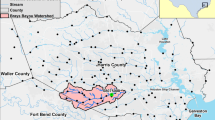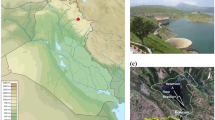Abstract
This study aims to develop a Machine Learning (ML)-based technique to infer reservoir management rules and predict downstream discharge values. The case study is the Hackensack River Watershed in New Jersey, USA. A Long Short-Term Memory (LSTM) model was used to predict streamflow values at the USGS station at New Milford, right downstream of Oradell reservoir. A good agreement between observed and simulated streamflow values was obtained during the 2020–2021 testing period. An NSE value of 0.93 was determined with the 48-h precipitation lead time, suggesting that the 48-h precipitation forecast mostly drives releases Oradell reservoir. The developed model was tested during Hurricane Ida. The analysis revealed that a similar NSE of 0.95 was obtained with a 48-h precipitation lead time followed by the 12-h lead time model, which was based on the watershed response time. In addition, the conducted feature analysis revealed that only four out of the seven upstream USGS stations in the watershed have a significant impact on the model’s performance. This work implies that ML can capture reservoir management rules and predict reservoir releases using precipitation and upstream flow data as input variables. This study lays the groundwork for a generalization of the method over the CONUS to infer reservoirs’ operation rules for streamflow simulation.










Similar content being viewed by others
Explore related subjects
Discover the latest articles, news and stories from top researchers in related subjects.References
Chen Y, Liu R, Barrett D et al (2015) A spatial assessment framework for evaluating flood risk under extreme climates. Sci Total Environ 538:512–523. https://doi.org/10.1016/j.scitotenv.2015.08.094
Sharifan RA, Roshan A, Aflatoni M et al (2010) Uncertainty and sensitivity analysis of SWMM model in computation of Manhole water depth and subcatchment peak flood. Procedia Soc Behav Sci 2:7739–7740. https://doi.org/10.1016/j.sbspro.2010.05.205
Wang K-H, Altunkaynak A (2012) Comparative case study of rainfall-runoff modeling between SWMM and fuzzy logic approach. J Hydrol Eng 17:283–291. https://doi.org/10.1061/(ASCE)HE.1943-5584.0000419
Krebs G, Kokkonen T, Valtanen M et al (2013) A high resolution application of a stormwater management model (SWMM) using genetic parameter optimization. Urban Water J 10:394–410. https://doi.org/10.1080/1573062X.2012.739631
Sahoo GB, Ray C, de Carlo EH (2006) Calibration and validation of a physically distributed hydrological model, MIKE SHE, to predict streamflow at high frequency in a flashy mountainous Hawaii stream. J Hydrol 327:94–109. https://doi.org/10.1016/j.jhydrol.2005.11.012
Loi NK, Liem ND, Tu LH et al (2019) Automated procedure of real-time flood forecasting in Vu Gia–Thu Bon river basin, Vietnam by integrating SWAT and HEC-RAS models. J Water Clim Change 10:535–545. https://doi.org/10.2166/wcc.2018.015
Goodall J, Morsy M, Sadler J (2017) Real-time flood prediction using data-driven and hydrodynamic modeling tools. Model Manag Extrem Precip 10:535–545
Follum ML, Tavakoly AA, Niemann JD, Snow AD (2017) AutoRAPID: a model for prompt streamflow estimation and flood inundation mapping over regional to continental extents. JAWRA J Am Water Resour Assoc 53:280–299. https://doi.org/10.1111/1752-1688.12476
Wang X, Kinsland G, Poudel D, Fenech A (2019) Urban flood prediction under heavy precipitation. J Hydrol 577:123984. https://doi.org/10.1016/j.jhydrol.2019.123984
Teng J, Jakeman AJ, Vaze J et al (2017) Flood inundation modelling: a review of methods, recent advances and uncertainty analysis. Environ Model Softw 90:201–216. https://doi.org/10.1016/j.envsoft.2017.01.006
Solomon S, Plattner G-K, Knutti R, Friedlingstein P (2009) Irreversible climate change due to carbon dioxide emissions. Proc Natl Acad Sci 106:1704–1709. https://doi.org/10.1073/pnas.0812721106
Mirzaei M, Huang YF, El-Shafie A, Shatirah A (2015) Application of the generalized likelihood uncertainty estimation (GLUE) approach for assessing uncertainty in hydrological models: a review. Stoch Env Res Risk Assess 29:1265–1273. https://doi.org/10.1007/s00477-014-1000-6
Saleh F, Ramaswamy V, Wang Y et al (2017) A multi-scale ensemble-based framework for forecasting compound coastal-riverine flooding: the Hackensack-Passaic watershed and Newark Bay. Adv Water Resour 110:371–386. https://doi.org/10.1016/j.advwatres.2017.10.026
Nourani V, Komasi M (2013) A geomorphology-based ANFIS model for multi-station modeling of rainfall–runoff process. J Hydrol 490:41–55. https://doi.org/10.1016/j.jhydrol.2013.03.024
Sudheer Ch, Maheswaran R, Panigrahi BK, Mathur S (2014) A hybrid SVM-PSO model for forecasting monthly streamflow. Neural Comput Appl 24:1381–1389. https://doi.org/10.1007/s00521-013-1341-y
Rasouli K, Hsieh WW, Cannon AJ (2012) Daily streamflow forecasting by machine learning methods with weather and climate inputs. J Hydrol 414–415:284–293. https://doi.org/10.1016/j.jhydrol.2011.10.039
Yaseen ZM, Jaafar O, Deo RC et al (2016) Stream-flow forecasting using extreme learning machines: a case study in a semi-arid region in Iraq. J Hydrol 542:603–614. https://doi.org/10.1016/j.jhydrol.2016.09.035
Adnan RM, Liang Z, Trajkovic S et al (2019) Daily streamflow prediction using optimally pruned extreme learning machine. J Hydrol 577:123981. https://doi.org/10.1016/j.jhydrol.2019.123981
Kisi O, Cimen M (2011) A wavelet-support vector machine conjunction model for monthly streamflow forecasting. J Hydrol 399:132–140. https://doi.org/10.1016/j.jhydrol.2010.12.041
Fang W, Huang S, Ren K et al (2019) Examining the applicability of different sampling techniques in the development of decomposition-based streamflow forecasting models. J Hydrol 568:534–550. https://doi.org/10.1016/j.jhydrol.2018.11.020
Rathinasamy M, Adamowski J, Khosa R (2013) Multiscale streamflow forecasting using a new Bayesian Model Average based ensemble multi-wavelet Volterra nonlinear method. J Hydrol 507:186–200. https://doi.org/10.1016/j.jhydrol.2013.09.025
Prasad R, Deo RC, Li Y, Maraseni T (2017) Input selection and performance optimization of ANN-based streamflow forecasts in the drought-prone Murray Darling Basin region using IIS and MODWT algorithm. Atmos Res 197:42–63. https://doi.org/10.1016/j.atmosres.2017.06.014
Alvisi S, Franchini M (2011) Fuzzy neural networks for water level and discharge forecasting with uncertainty. Environ Model Softw 26:523–537. https://doi.org/10.1016/j.envsoft.2010.10.016
Allawi MF, Jaafar O, Mohamad Hamzah F et al (2018) Review on applications of artificial intelligence methods for dam and reservoir-hydro-environment models. Environ Sci Pollut Res 25:13446–13469. https://doi.org/10.1007/s11356-018-1867-8
Raman H, Chandramouli V (1996) Deriving a general operating policy for reservoirs using neural network. J Water Resour Plan Manag 122:342–347. https://doi.org/10.1061/(ASCE)0733-9496(1996)122:5(342)
Deka P, Chandramouli V (2003) A fuzzy neural network model for deriving the river stage—discharge relationship. Hydrol Sci J 48:197–209. https://doi.org/10.1623/hysj.48.2.197.44697
Chang F-J, Chang Y-T (2006) Adaptive neuro-fuzzy inference system for prediction of water level in reservoir. Adv Water Resour 29:1–10. https://doi.org/10.1016/j.advwatres.2005.04.015
Nourani V, Hosseini Baghanam A, Adamowski J, Kisi O (2014) Applications of hybrid wavelet–Artificial Intelligence models in hydrology: a review. J Hydrol 514:358–377. https://doi.org/10.1016/j.jhydrol.2014.03.057
Shiri J, Shamshirband S, Kisi O et al (2016) Prediction of water-level in the Urmia Lake using the extreme learning machine approach. Water Resour Manage 30:5217–5229. https://doi.org/10.1007/s11269-016-1480-x
Emamgholizadeh S, Moslemi K, Karami G (2014) Prediction the Groundwater Level of Bastam Plain (Iran) by Artificial Neural Network (ANN) and Adaptive Neuro-Fuzzy Inference System (ANFIS). Water Resour Manage 28:5433–5446. https://doi.org/10.1007/s11269-014-0810-0
Hochreiter S, Schmidhuber J (1997) Long short-term memory. Neural Comput 9:1735–1780. https://doi.org/10.1162/neco.1997.9.8.1735
Hu J, Zheng W (2019) Transformation-gated LSTM: efficient capture of short-term mutation dependencies for multivariate time series prediction tasks. In: 2019 International Joint Conference on Neural Networks (IJCNN). IEEE, pp 1–8
Mouatadid S, Adamowski JF, Tiwari MK, Quilty JM (2019) Coupling the maximum overlap discrete wavelet transform and long short-term memory networks for irrigation flow forecasting. Agric Water Manag 219:72–85. https://doi.org/10.1016/j.agwat.2019.03.045
Zhang D, Lin J, Peng Q et al (2018) Modeling and simulating of reservoir operation using the artificial neural network, support vector regression, deep learning algorithm. J Hydrol 565:720–736. https://doi.org/10.1016/j.jhydrol.2018.08.050
Kratzert F, Klotz D, Brenner C et al (2018) Rainfall–runoff modelling using Long Short-Term Memory (LSTM) networks. Hydrol Earth Syst Sci 22:6005–6022. https://doi.org/10.5194/hess-22-6005-2018
Ni L, Wang D, Wu J et al (2020) Streamflow forecasting using extreme gradient boosting model coupled with Gaussian mixture model. J Hydrol 586:124901. https://doi.org/10.1016/j.jhydrol.2020.124901
Hu C, Wu Q, Li H et al (2018) Deep learning with a long short-term memory networks approach for rainfall-runoff simulation. Water (Basel) 10:1543. https://doi.org/10.3390/w10111543
Mignot E, Li X, Dewals B (2019) Experimental modelling of urban flooding: a review. J Hydrol 568:334–342. https://doi.org/10.1016/j.jhydrol.2018.11.001
Yuan X, Chen C, Lei X et al (2018) Monthly runoff forecasting based on LSTM–ALO model. Stoch Env Res Risk Assess 32:2199–2212. https://doi.org/10.1007/s00477-018-1560-y
U.S. Department of the Interior USGS (2022) USGS Water Data for USA https://waterdata.usgs.gov/nwis
PANYNJ (2013) Port Authority of New York and New Jersey Teterboro Airport 2013 Sustainability Report
Gourley JJ, Flamig ZL, Vergara H et al (2017) The FLASH Project: improving the tools for flash flood monitoring and prediction across the United States. Bull Am Meteorol Soc 98:361–372. https://doi.org/10.1175/BAMS-D-15-00247.1
Jian Zhang JG (2018) Multi-Radar Multi-Sensor Precipitation Reanalysis (Version 1.0). In: Open Commons Consortium Environmental Data Commons. https://doi.org/10.25638/EDC.PRECIP.0001
Sagheer A, Kotb M (2019) Time series forecasting of petroleum production using deep LSTM recurrent networks. Neurocomputing 323:203–213. https://doi.org/10.1016/j.neucom.2018.09.082
Greff K, Srivastava RK, Koutnik J et al (2017) LSTM: a search space Odyssey. IEEE Trans Neural Netw Learn Syst 28:2222–2232. https://doi.org/10.1109/TNNLS.2016.2582924
Mangalathu S, Hwang S-H, Jeon J-S (2020) Failure mode and effects analysis of RC members based on machine-learning-based SHapley Additive exPlanations (SHAP) approach. Eng Struct 219:110927. https://doi.org/10.1016/j.engstruct.2020.110927
Office of Water Prediction (2022) The National Water Model. https://water.noaa.gov/about/nwm. Accessed 17 Jan 2022
Acknowledgements
The authors acknowledge the financial support received from the Port Authority of New York and New Jersey.
Author information
Authors and Affiliations
Corresponding author
Ethics declarations
Conflict of interest
No potential conflict of interest to declare.
Additional information
Publisher's Note
Springer Nature remains neutral with regard to jurisdictional claims in published maps and institutional affiliations.
Rights and permissions
About this article
Cite this article
Tounsi, A., Temimi, M. & Gourley, J.J. On the use of machine learning to account for reservoir management rules and predict streamflow. Neural Comput & Applic 34, 18917–18931 (2022). https://doi.org/10.1007/s00521-022-07500-1
Received:
Accepted:
Published:
Issue Date:
DOI: https://doi.org/10.1007/s00521-022-07500-1




